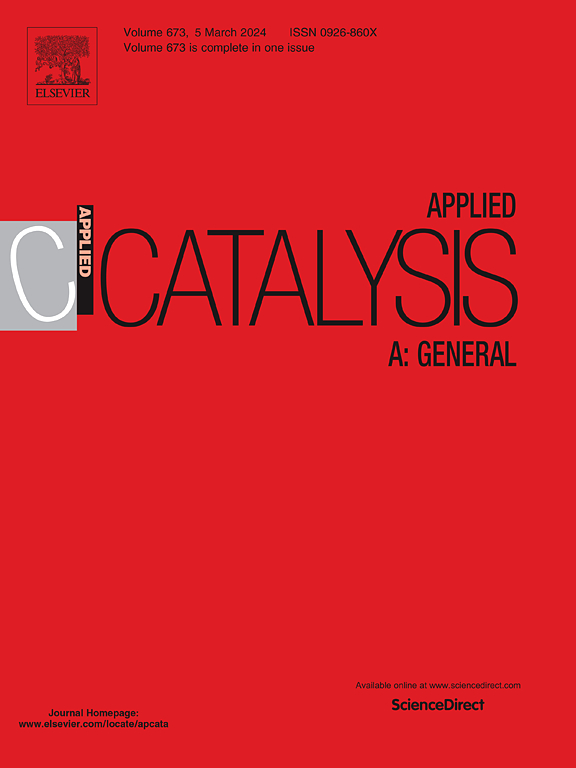Developing a supported metal oxide catalyst for direct dehydrogenation of propane to propene
IF 4.7
2区 化学
Q2 CHEMISTRY, PHYSICAL
引用次数: 0
Abstract
Propene is an important building block in the petrochemical industry and its demand is rapidly increasing. However, the production through conventional processes is limited, and there is a dire need to develop a suitable catalyst for the direct dehydrogenation of propane. Multiple set of catalysts are synthesized via incipient wetness impregnation method and characterized by various techniques. These catalysts are also tested for the direct dehydrogenation reaction, to examine the effect of active metal oxide species, support material, metal oxide loading and potassium (K) loading. Subsequently, the reaction temperature and contact time are optimized for the reaction. A near-monolayer loading chromium oxide supported on ZrO2 is the most active. At this loading incipient amounts of Cr2O3 crystallites are detected, which became larger at higher coverages. The monolayer coverage appears to be between 5.2 and 6.6 . Furthermore, at this coverage the amount of reducible Cr+6 species was maximum. The activity of this near-monolayer catalyst is further improved by co-impregnating K. A Cr to K molar ratio of 1:0.05 is found to increase the amount of reducible Cr+6 and the catalyst activity and selectivity. Increasing the K amount further leads to a decrease in activity. Activity is increased by increasing the reaction temperature till 550 ℃; however, above 550 ℃ the catalyst deactivates due to coke formation. Further improvement in activity is achieved by increasing the contact time and a conversion of ∼30 % and yield of ∼27 % is achieved for the K-promoted supported chromia catalyst at 550 °C and a contact time of 37.33 .
丙烷直接脱氢制丙烯负载型金属氧化物催化剂的研制
丙烯是石油化工的重要原料,其需求量正在迅速增长。然而,传统工艺的产量是有限的,迫切需要开发一种适合丙烷直接脱氢的催化剂。采用初湿浸渍法合成了多组催化剂,并采用多种工艺对其进行了表征。对这些催化剂进行了直接脱氢反应试验,考察了活性金属氧化物种类、载体材料、金属氧化物载荷和钾(K)载荷的影响。随后,对反应温度和接触时间进行了优化。ZrO2负载的近单层氧化铬是最活跃的。在此加载过程中,检测到初始数量的Cr2O3晶体,其在更高的覆盖范围内变得更大。单层膜的覆盖率在5.2 ~ 6.6 atomCr/nm2之间。此外,在这种覆盖下,可还原性Cr+6的数量最大。Cr与K的摩尔比为1:0.05时,Cr+6的可还原性增加,催化剂的活性和选择性提高。进一步增加钾含量会导致活性降低。将反应温度提高到550℃,活性有所提高;然而,在550℃以上,催化剂因结焦而失活。通过增加接触时间,进一步提高了活性,在550℃、37.33 gcat.h/mol的接触时间下,k促进负载型铬催化剂的转化率为~ 30%,产率为~ 27%。
本文章由计算机程序翻译,如有差异,请以英文原文为准。
求助全文
约1分钟内获得全文
求助全文
来源期刊

Applied Catalysis A: General
化学-环境科学
CiteScore
9.00
自引率
5.50%
发文量
415
审稿时长
24 days
期刊介绍:
Applied Catalysis A: General publishes original papers on all aspects of catalysis of basic and practical interest to chemical scientists in both industrial and academic fields, with an emphasis onnew understanding of catalysts and catalytic reactions, new catalytic materials, new techniques, and new processes, especially those that have potential practical implications.
Papers that report results of a thorough study or optimization of systems or processes that are well understood, widely studied, or minor variations of known ones are discouraged. Authors should include statements in a separate section "Justification for Publication" of how the manuscript fits the scope of the journal in the cover letter to the editors. Submissions without such justification will be rejected without review.
 求助内容:
求助内容: 应助结果提醒方式:
应助结果提醒方式:


